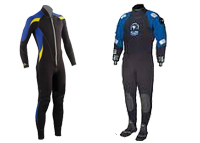Diving suit

While scuba diving in water that is colder than the normal body temperature (~37°C), the temperature of the diver will decrease. This will cause indispositions such as prolonged ability to react, shivering and higher air consumption. So even in warm, tropical water it is useful to wear a suit as thermal protection as well as defense from sharp obstacles and some harmful marine life.
Wet suit
The most common scuba suits used for diving are wet suits. They are made from neoprene, a synthetic rubber foam containing innumerable tiny gas bubbles. The thickness of the neoprene comes between 2mm and 9mm. The thicker the suit, the warmer it keeps, even if the thicker ones are a bit bulky and more difficult to put on. The diver should choose the adequate size of his suit according to the water temperature he will dive in.
Added buoyancy, depending on the volume of the wet suit has to be taken into consideration.
To achieve the maximum insulation from the cold, the wet suit must fit properly. It has to be snug (not too tight) all over the body. When entering the water, the space between skin and suit is filled up with a small layer of water, which is warmed up to the body temperature and protects from cooling down. Loose areas inside the suit will allow the water to circulate and will reduce the insulation. The thermal protection and buoyancy also is reduced in the depth as the gas bubbles in the neoprene are compressed.
Wet suits are designed in different models, such as
- Shorty (thin material, short arms and legs)
- Overall (one piece, with or without integrated hood)
- Long john and jacket (two pieces – the core body is double covered)
For divers who have specific requirements regarding size, perfect fit, detail etc. custom made wet suits are offered as well.
Semi-dry suit
Semi-dry suits are used to dive in colder water (between 10-20 °C). They are available in thicker neoprene, from 5mm to 9mm. The thermal protection is higher than the one of the wet suits, as they come with special, tight fitting seals at neck, wrists, ankles and at the zipper. Some models even are offered with dry-zips. These seals ensure the reduction of water circulating inside the suit to a minimum, so the diver keeps warmer than in a wet suit.
Semi-dry suits are also offered in different styles, as overalls and long john – jacket models. They can be tailor-made as well.
Dry suit
For scuba diving in cold water divers can choose a dry suit. They are more expensive than wet suits but their thermal protection is by far the best. Dry suits are made from different materials, such as neoprene, crushed neoprene, tri-laminate (nylon) or vulcanized rubber. Due to special seals at the neck and the wrists, a waterproof zipper and integrated booties they keep the divers dry. The insulation effect is achieved by two things: the underwear which the diver wears in his suit and trapped air which is warmed up by the body temperature. A variety of special dry suit underwear is offered in different materials and different insulation potential, which can be chosen depending on the water temperature and personal needs.
Dry suits are equipped with an inflator valve (connected to the 1. stage of the regulator) and a dump valve to control the air volume (buoyancy) during the dive.
To get advice ask the instructors, or share your opinions with other divers in the diving equipment forum.
Look at the diving center directory to find a dive shop or diving center in your region.
All information and opinions provided are general and no substitute for professional advice. Always check with your diving instructor what fits best to your personal needs and to your level of training.











